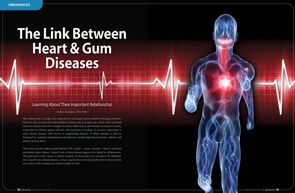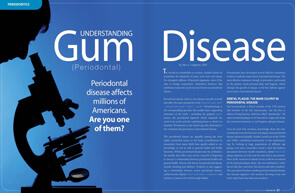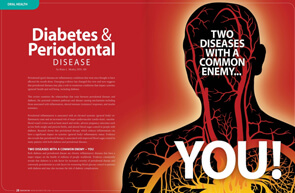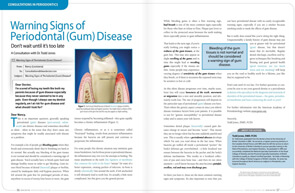Periodontal Treatment
Periodontal Treatment for Healthy Gums, London
We're all familiar with routine cleaning of the teeth, but we take fresh breath and gum care a step further. Laser Dentistry can harness laser energy and its ability to help in healing. Preventing and fixing gums disease, and preventing bone loss & gum recession which can leave us with teeth that look too long.
Another simple procedure which allows us to redcuce gum pockets formed over the years.
It creates a healthy, fiurm foundation for your teeth with a signifficant reduction in bacteria and the elimination of bleeding gums.
Uses :
- Reduce/Eliminate bacterial "gum [ockets"
- Halitotis (bad breath)
- Receding gums and jaw dissolution
- Loose teeth
- Maintenance of Restorative work
Mainting healthy gums has become an important part of a modern healthy lifestyle. Current research shows a link between cardiovascular and peridontal (i.e. gum) health.
Left unchecked, bacteria can use the gums as a doorway to our body.
Our laser gum therapy is used in conjunction with traditional gum therapies for optimal results.
Most of us suffer from some level of gum problems in our life time. Red, Swollen, tender and bleeding gums are a sign of gum disease. This is often associated with constant bad breath or bad taste and loose teeth to a varying degree. As patients can have gum disease and not be aware or exhibit all the above symptoms, our practice policy is to monitor the gum health of every patient and formulate a prevention plan to treat and maintain optimum gum health.
What is Periodontitis?
Periodontitis is the most serious of the periodontal diseases, commonly referred to as gum diseases. It is remarkably common in adults over the age of 35, with some sources estimating that up to one third of American adults (more than 50 million people) suffer from some form of periodontitis. Periodontitis is the number one cause of tooth loss in adults, and is particularly prevalent in smokers and those with complicating diseases such as diabetes and osteoporosis. There are also some individuals who are genetically predisposed to developing this disease.
What Causes Periodontitis?
Periodontitis is the end result of a complex interaction between the bacteria (or plaque) that accumulates on tooth surfaces and your own body's efforts to fight this bacterial infection. Everyone has bacteria in their mouth; if you follow normal oral hygiene procedures (brushing and flossing) and see your dentist regularly, under most circumstances these bacteria live in balance with your body's defense mechanisms. However, if the bacteria build up on the tooth near the gums, and particularly if your body's defense mechanisms are compromised, then an imbalance can arise and your gums will become red and inflamed. This inflammation, if left untreated, eventually results in damage to the ligaments and bone which hold your teeth in place, and in the worst cases can cause the teeth to become loose or to be lost.
The Progression of Gum Disease
In its earliest stages, gum disease is referred to as gingivitis inflammation of the gums. Every day a clear sticky film called plaque builds up on the surface of the tooth. Plaque is made up of bacteria and their secretions, and it is easily removed by proper brushing and flossing. However, if plaque is allowed to build up, then eventually the gum tissue in contact with the plaque becomes red and inflamed. You may have observed that sometimes your gums bleed when you brush your teeth. This is because of the inflammation, and is often the first sign that you have the earliest stages of periodontal disease. In most cases, a thorough professional cleaning from your dental professional, and more attention to brushing and flossing can reverse the inflammation and bleeding associated with gingivitis.
Treatment
- Oral hygiene instruction brushing and flossing advise and the use of single tufted brushes
- Disclosing to help you visulaise
- Routine vists with the hygienist or periodontist for scaling cleaning root debridment and maintenance.
- The use of medication including antibiotic s both short and long term ie Periostat
- And regenerative surgical procedures including the use of emdogain.
Why is Periostat® (doxycycline hyclate) Prescribed for Periodontitis?
Periostat® Dosage and Duration of Treatment
Periostat® is available as a capsule to be taken twice daily, about an hour before meals. Periostat® should be taken with plenty of fluids. If you forget to take a dose, just take the normal dose of 1 capsule at the next scheduled dose. Do not double up to make up for the missed capsule.
In clinical studies, Periostat® was proven to be safe when taken for as long as 12 months. Typically, the drug is taken for periods of no less than three months. Your dentist or periodontist will tell you how long you should take Periostat®.
Periostat® is a unique dosage of a drug called doxycycline. The dosage of Periostat® differs from that of doxycycline used to treat infections. Exceeding the recommended dosage may result in an
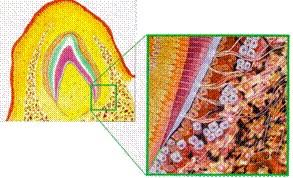
Detail of the period when the root sheath cells (blue) secrete enamel matrix proteins. Following formation of the protein matrix on the surface of the mineralizing dentin, cementoblasts (Red) start producing cementum (Light blue) which anchors collagen fibers.
In the mid 1980's, a revolutionary breakthrough in the basic biology of tooth development took place at the Karolinska Institute's department of Oral Pathology in Stockholm. The discovery revealed a native complex of enamel matrix proteins and the key if not crucial , role they play in the development of tooth-supporting tissues. These enamel related proteins mediate the formation of acellular cementum on the root of the developing tooth, providing a foundation for all of the necessary tissues associated with a functional periodontal attachment.
This groundbreaking discovery has fueled the development of a new generation in periodontal therapy, and makes the recreation of lost tooth support an attainable goal in the treatment of patients suffering from periodontitis.
It Begins with a single product... Emdogain
Is an enamel matrix protein that recreates all necessary tissues of true functional attachment in patients presenting with moderate to advanced peridontitis.
Emdogain represents a completely new way of thinking about the regain of functional tooth support. Designed to be a simple adjunctive product, Emdogain fits naturally into established periodontal treatments. The Emdogain product is packaged in two vials - a vehicle solution and freeze dried enamel matrix proteins (The amelogenin fraction). When mixed, they create a viscous, easy to use, syringable gel that is applied quickly and easily during normal flap surgery.
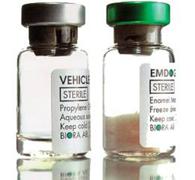
Emdogain prompts a natural biology-based response in the body.
Emdogain is resorbed naturally during the normal healing process, leaving only a residue of enamel matrix protein on the debrided root surface. This natural and insoluble surface layer encourages the population of cementum-forming cells from the surrounding tissues.
The newly created surface also functions as an interface between the tooth and the surrounding tissues, preventing downgrowth of the epithelial tissues.
In promoting rapid initial healing, Emdogain causes little or no associated postoperative pain and swelling.
Emdogain creates a surface for cementum production
Experimental studies in a marginal dehiscence model in primates show that Emdogain creates a suitable surface for the colonization of cementum-forming cells. Two weeks after application, 75% of the dentin surface is covered with such cells. After cementum formation, the periodontal ligament and alveolar bone are then established.
Emdogain promotes growth of all periodontal tissues:
- Acellular cementum
- Functional periodontal tissues
- Alveolar bone
- The histological picture to the left shows periodontal regeneration in an experimental dehiscence defect in a primate eight weeks after Emdogain treatment.
- A firmly attached acellular cementum (C) with collagen fibers (ARROWS) can be seen extending over to the newly formed alveolar bone (AB).
- The polarized light also shows how the collagenus fibers extend deeply into the newly-formed cementum.
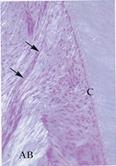
A product as safe as it is effective!
The safety of Emdogain has been completely documented. A thorough toxicology program, including acute and chronic toxicity studies, in vitro mutagenicity studies, reproductive toxicological tests, and several additional toxicology studies has been carried out. The potential for sensitization and other immunological reactions in humans were also examined. No immunological or allergic reactions were found.
Clinical documentation for Emdogain has been obtained from series of strictly designed studies involving nearly 300 patients at 15 clinics throughout the US. and Sweden. Patients have been followed for over three years and have shown uniform improvement in Emdogain treated teeth compared to control surgery, by achieving statistical significance for probing pocket reduction, clinical attachment gain and radiographic bone gain.
Each patient had a test site treated with flap surgury and adjunctive Emdogain and a control site (of similar morphology and in the same jaw) treated with an identical surgical procedure that did not include Emdogain Look at the facts
- Female
- 51 years
- Smoker
- Generalized adult periodontitis with horizontal & verical bone loss.
Initial probing pocket depth-10mm
Clinical Attachment loss - 12mm
8 months after flap surgery and single application of EMODOGAIN resulting in:
Probing pocket reduction - 8mm
Clinical Attachment gain - 7mm
Radiographic bone gain - 7mm
Clinical trial results show that Emdogain gains both clinical attachment and bone in 93% of cases. Studies also shows that patients with periodontal pockets (more than 6mm) of the 1-wall and 2-wall type may except to achieve significant alveolar bone regain up to 60-70% defect fill.

Air abrasion can help the dentist provide better care while providing you greater comfort during your visit.
If the whine of the drill sets your nerves on edge, you may be an excellent candidate for air abrasion. This advanced new technique painlessly removes microscopic amounts of tooth decay, sparing healthy tooth structure in the process. These advantages make air abrasion an attractive alternative to conventional high-speed drill preparations.
The facts about Air Abrasion
The air abrasive system replaces a conventional dental drill in the preparation of tooth surfaces when filling cavities. A thin direct stream of aluminum oxide particles driven by compressed air at high velocity "blasts" away decay with virtually no loss of healthy tooth material. The technique is limited to use on cavities close to or on the surface which makes it useful for about 80 percent of children and 40 percent of adults.
How safe is Air Abrasion
Very. Approved by both the Food and Drug Administration and the American Dental Association, air abrasion is so safe it can even be used on small children and pregnant women.
Will I need an anesthetic during the procedure?
In the majority of cases, no anesthetic injection is necessary. Most patients remain comfortable throughout the procedures with no numbness afterward. However, if you are one of the rare people who are uneasy, we will be happy to take appropriate measures to ensure your comfort.
Is the procedure safe for children?
Yes. In fact, due to the improved comfort level and speed of air abrasion, it's often the treatment of choice for children. Many children treated with air abrasion early on avoid the apprehension (dental anxiety) that traditional methods may stimulate.
What steps are involved?
Because air abrasion is most often used on conservative restorations, we first apply a special cavity detection dye to your teeth to identify the location and extent of decay that might otherwise go undetected by x-rays and visual examinations. We then use an instrument that delivers a gentle stream of compressed air and a superfine powder of abrasive particles to quickly remove the decay. Finally, we fill the cavity with a tooth-colored, non-metallic filling that offers many benefits over mercury fillings, including strength, longevity and appearance.
What does the procedure Feel like?
Many patients say it feels and sounds similar to air being blown across the tooth. The procedure moves so quickly that some people aren't even aware that the air abrasion process is underway.
What are the benefits of Air Abrasion?
- Prevention - Earlier detection and treatment of cavities means less damage to teeth.
- Speed - Most air abrasion fillings can be completed in 10 to 15 minutes or less.
- Comfort - Greatly reduced vibrations, sounds and unpleasant sensations.
- Precision - Helps maintain integrity of tooth structure by removing only a minimal section of tooth.
- Appearance - Improved, tooth-colored filling material looks more natural and provides additional benefits over mercury fillings.
A thin stream of aluminum oxide particles driven by compressed air sprays away decay.
What procedures can Air Abrasion perform?
Air abrasion is most often used to remove decay in its early stages. It can also remove stains, repair chipped, fractured or worn teeth and prepare teeth for cosmetic procedures.
What are the limitations o Air Abrasion
While air abrasion offers many benefits, it is not always appropriate for all procedures, such as removing large silver (amalgam) fillings or removing deep decay. Based on your individual situation, we will determine what technology is most beneficial to you.
Air abrasion is safe for children as well as adults.
A final word
Air abrasion helps many people feel more comfortable with dental treatment. This improved comfort level leads to less anxiety about visits to the dentist for routine care, which in turn allows us to catch many problems while they are still small. We think you will be pleased with this proven technology and we welcome your questions. It's all a part of our quest to help you keep your smile for a lifetime!
Dental erosion is the process whereby tooth enamel (and dentine) are destroyed by the action of acid on the teeth. The acid may be of endogenous origin (i.e. from within the body) or exogenous (from outside the body). This is a different process to the damage caused by acid from decay producing bacteria.
Unlike tooth decay erosion affects the whole surface of the tooth. Exposure to acid over a long period of time leads to progressive loss of enamel with the effect that the tooth "shrinks" and crumbles at the biting edge. Eventually the dentine is exposed leading to pain and sometimes death of the tooth.
The process is irreversible and requires expensive aesthetic dentistry to restore function and appearance.
What is dental erosion?
Erosion is the loss of tooth enamel caused by acid attack. Enamel is the hard, protective coating of the tooth, which protects the sensitive dentine underneath. When the enamel is worn away, the dentine underneath is exposed, which may lead to pain and sensitivity.
How do I know I have dental erosion?
Erosion usually shows up as hollows in the teeth and a general wearing away of the tooth surface and biting edges. This can expose the dentine underneath, which is a darker, yellower colour than the enamel. Because the dentine is sensitive your teeth can also be more sensitive to hot, cold or sweet foods and drinks.
What causes dental erosion?

Every time you eat or drink anything acidic, the enamel on your teeth becomes softer for a short while, and loses some of its mineral content. Your saliva will slowly neutralise this acidity in your mouth and restore it to its natural balance. However, if this acid attack happens too often, the mouth does not have a chance to repair itself and tiny particles of enamel can be brushed away. Over time, you would start to lose the surface of your teeth.
Are there any medical problems which can cause dental erosion?
Bulimia is a condition where patients make themselves sick so that they lose weight. Because there are high levels of acid in the vomit, this can cause damage to tooth enamel. Acids produced by the stomach can come up into the mouth (this is called gastro-oesophageal reflux). People suffering from Hiatus hernia and other oesophageal problems, or who drink too much alcohol, may also find they suffer from dental erosion due to vomiting.
Can my diet help prevent it?
Acidic foods and drinks such as fruit and fruit juices, particularly citric ones including lemon and orange, can be particularly harmful to teeth. Fruit juices and fruits contain natural acids, which can be just as harmful to teeth. Fizzy drinks are also a cause of enamel erosion. It is important to remember that even the diet brands are still as harmful. Even flavoured fizzy waters can have an effect if taken in large amounts, as they contain certain acids which can harm the teeth.
It is important to have acidic foods and drinks at mealtimes only.
Healthy foods such as fruit and fruit juices are not always the best options for teeth if you have too much of them. It is also recommended that you do not brush your teeth for at least one hour after eating or drinking anything acidic, so that your teeth can build up their mineral content again.
Are sports drinks safe?
Many sports drinks contain ingredients that can cause dental erosion. However, it is important for athletes to avoid dehydration, because this can lead to a dry mouth and bad breath.
What can I do to prevent dental erosion?
Limit acidic products and fizzy drinks to mealtimes to reduce the number of acid attacks on your teeth. • Drinks should be drunk quickly without holding in or 'swishing' around your mouth. Or use a straw to help drinks go to the back of your mouth and avoid long contact with your teeth. • Finish a meal with cheese or milk as this will help neutralise the acid. • Chew sugar-free gum after eating to help produce more saliva to help cancel out the acids which form in your mouth after eating. • Wait for at least one hour after eating or drinking anything acidic before brushing your teeth. This gives your teeth time to build up their mineral content again. • Brush your teeth twice a day with a small-headed brush with medium to soft bristles and fluoride toothpaste.
Should I use any other special products?
We recommend you use a fluoride toothpaste twice a day. In severe cases fluoride supplements such as rinses and gels may be used once a day. Your dentist or hygienist will tell you the best supplement to use.
How can it be treated?
Dental erosion does not always need to be treated. With regular check ups your dentist can prevent the problem getting any worse and the erosion going any further. In other cases it is important to protect the tooth and the dentine underneath to prevent tooth decay and sensitivity. In these cases, simply bonding a filling onto the tooth will be enough to repair it. However in more severe cases the dentist may need to fit a veneer. (See Tell Me About Veneers)
How much will treatment cost?
Costs can vary, depending on the type of treatment necessary and your method of payment. It is important to discuss all the treatment options with your dentist and be sure to get a written estimate before starting treatment.
1. "Pop" drinkers.
The commonest sufferers from tooth erosion are teenagers whose main drink is "pop" (Coca Cola, lemonade or other similar fizzy drinks). All the fizzy drinks have a high acidity and rapidly dissolve enamel. The more frequent the consumption the more damage is done. Those who swish the drink round their teeth are the worst affected. Using a straw does not prevent damage. It probably transfers the problem from front teeth to back teeth.
2. Pure fruit juice drinkers
People who drink pure fruit juices which are very acidic as their main drink have similar problems to pop drinkers.
3. People with eating disorders
Bulimia or frequent gastric regurgitation or vomiting causes tooth destruction by stomach acids. Medical (and dental) advice should be sought as soon as possible.
Recommendation:
DO NOT BRUSH your teeth straight after drinking an acid drink or vomiting. After acid exposure the enamel is softened. Calcium salts in saliva will rematerialize and harden some of the softened enamel given time. Therefore do not brush your teeth straight after drinking an acid drink as the softened enamel will be further damaged by the brushing and speed up the process of erosion. Wait at least half an hour before brushing.
Safe drinks:
- Water (has your water got fluoride in it? If not why not?)
- Milk, Tea and Coffee (without sugar)
- Dilute sugar free squashes such as "Robinson's Special R".
Summary
Excess acid from drinks or gastric acid cause irreversible enamel Loss.
Recommendation
:- No more than one acid drink per day
- Choose safe drinks
- Wait half an hour before brushing after an acid drink
What is Air Abrasion?
Air Abrasion is a gentle spray of an air and powder mix that removes tooth decay. By controlling the speed and the intensity of both the powder and the air,we can make the procedure virtually painless. Since a shot is not necessary in most cases, you will not have numb or drooping lips after your dental procedure.
Air Abrasion almost never hurts - making it great for kids as well as adults.
Tell me a little more about air abrasion.
Since Air Abrasion is achieved by directing a thin stream of abrasive powder at the area of tooth decay, we remove only minimal sections of tooth - just the decayed area. Until now, all the dentist had available was that noisy drill. But it was so big in comparison to our beam of powder that it removed a lot of healthy tooth structure. Air Abrasion allows for very small cavity preparations and is part of what is called MicroDentistry.
Why is Air Abrasion better than the old drill?
The Air Abrasion device that we use is state-of-the-art. Its technology eliminates the odors, noise, vibration, micro-cracks and, in most cases, no shot associated with the drill.
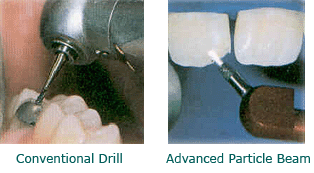
Related Periodontal (Gum) Disease Articles
Inflammation has emerged as a factor that is involved in the process of Cardiovascular Disease (CVD), which commonly results in heart attacks and strokes. While the precise role inflammation plays in causing chronic CVD remains an area of intense current investigation, much more is now known. The good news is that, based on current research, we know that if we can reduce the inflammation caused by periodontal disease, we can reduce the risk for heart attacks and strokes... Read Article
Diabetes and periodontal disease are chronic inflammatory diseases that impact the health of millions of people. What you may not know is that diabetes and periodontal disease can adversely affect each other... Read Article
Diabetes and periodontal disease are chronic inflammatory diseases that impact the health of millions of people. What you may not know is that diabetes and periodontal disease can adversely affect each other... Read Article
This article provides the warning signs of periodontal (gum) disease. Don't wait until it's too late... Read Article
